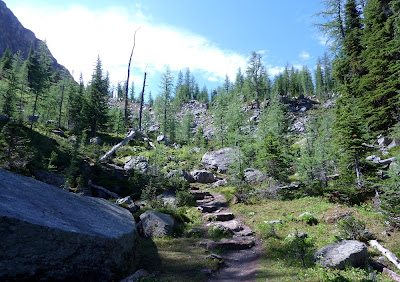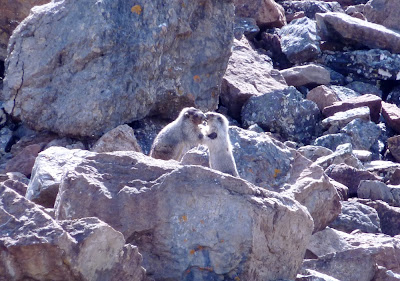However, notice the puffy white clouds so early in the morning? As we learned at a weather presentation at the Le Relais shelter, this indicates a high enough level of humidity in the atmosphere that afternoon precipitation is likely. Today this rule of thumb was true.
Our goal for today was to climb up to Sleeping Poet's Pool and then traverse the Yukness Ledges. The trail for the pool branches off from the Yukness route close to the East Opabin trail, so East Opabin was the first leg of our hike. This trail is broad and stays in a forested ravine for a long time as it rises to the Opabin Plateau.
We had a prime ornithological sighting early on. We heard the vigorous chirping of winter wrens as we approached the log in the above picture. Standing quietly and peering at the log, we discovered that a baby wren was begging for food, but the parents, who had been hunting, were unwilling to reveal the baby's location as long as we were standing there. The wrens are hyperkinetic, so the next two pictures are blurry.
First, here is the parent with its catch, waiting for a chance to slip over to the baby unobserved.
After a while the baby emerged, frowning, to see what was delaying its breakfast.
We moved on, gaining altitude through switchback after switchback until we reached the start of the plateau, where the trail forks. The left fork is the direct route to the Yukness Ledges trail.
The trail continues to rise, albeit more gradually. Because the path follows a creek, the ground is often wet, and stepping stones are provided.
The East Opabin trail continues on to Hungabee Lake, where the Yukness Ledges trail comes in from the left. Opabin Lake itself is just beyond the moraine in the center of the photo; we'll visit it on our last day at Lake O'Hara.
The first section of the Yukness Ledges trail climbs through the boulder field on the left; in places steps have been created.
Not long after guiding you up and up through the boulder field, the Yukness Ledges trail levels out; soon after, the trail to Sleeping Poet's Pool leaves to the right. Don't look for it on any map, unless you have an old Lake O'Hara map; it's no longer official nor publicized, and it is steep. Here a photo looking back at this trail, taken on another day. The Yukness Ledges trail is near the bottom, while the Sleeping Poet trail hauls almost straight up. Careful foot placement is required and poles are very handy.
The short trail leads to a ledge higher on the mountain; here, Joan has arrived on the ledge, but the pool is further on.
The pool itself was still largely covered in ice, being often in shadow.
The view from the edge is spellbinding.
Another party had climbed up to the pool, not far behind us, and they decided to lunch there.
It was a family group from Houston, and they kindly offered to take our picture. Joan and I rarely manage to get into the same frame, so we accepted. Note how the clouds are getting larger and thicker, compared to the day's start. We are both wearing binoculars, of course, and the holster on my belt is bear spray.
We did not lunch here, but we did take a rest stop. In the process Joan discovered this smooth alpine gentian, sometimes known as glaucous gentian or inky gentian. We don't often see it, so this piece of serendipity was a treat. Isn't the color striking?
There is only one way to leave Sleeping Poet's Pool, the way you came in. On the way down, I took this picture of a beardtongue, a large family of flowers.
Going down a steep slope is trickier, if less aerobic, than going up , and it's harder on the knees. In this photo, the trail looks moderate, but that's a deception: the camera is pointed down along the trail, not horizontally.
Partway along the Yukness Ledges trail, I took this picture of the Lake O'Hara basin. Compare it to the view from Sleeping Poet's Pool. Also, note that the clouds are becoming thicker.
We came across this example of snow melting around a rock; the rock absorbs heat from the sun much faster than the snow, and the snow melts back from it.
The Yukness Ledges trail is an excellent platform for observing hikers on other trails. From the portion closest to the Opabin Plateau, you can keep an eye on All Souls' Prospect and the associated alpine route. From the portions closer to Lake Oesa, much of that trail is laid out before you (click the photo to enlarge).
With binoculars, it is easy to check out the comings and goings on the Lake Oesa trail. Those folks on the right with large backpacks and orange rock helmets (click to enlarge) are almost certainly going up to the hut at Abbot Pass.
After we turned 90° to the right and climbed several short ledges, Lake Oesa itself came into view.
On this cloudy afternoon the lake has a different personalilty than it did two days ago.
The first section of the Yukness Ledges trail climbs through the boulder field on the left; in places steps have been created.
Not long after guiding you up and up through the boulder field, the Yukness Ledges trail levels out; soon after, the trail to Sleeping Poet's Pool leaves to the right. Don't look for it on any map, unless you have an old Lake O'Hara map; it's no longer official nor publicized, and it is steep. Here a photo looking back at this trail, taken on another day. The Yukness Ledges trail is near the bottom, while the Sleeping Poet trail hauls almost straight up. Careful foot placement is required and poles are very handy.
The short trail leads to a ledge higher on the mountain; here, Joan has arrived on the ledge, but the pool is further on.
The pool itself was still largely covered in ice, being often in shadow.
The view from the edge is spellbinding.
Another party had climbed up to the pool, not far behind us, and they decided to lunch there.
It was a family group from Houston, and they kindly offered to take our picture. Joan and I rarely manage to get into the same frame, so we accepted. Note how the clouds are getting larger and thicker, compared to the day's start. We are both wearing binoculars, of course, and the holster on my belt is bear spray.
We did not lunch here, but we did take a rest stop. In the process Joan discovered this smooth alpine gentian, sometimes known as glaucous gentian or inky gentian. We don't often see it, so this piece of serendipity was a treat. Isn't the color striking?
There is only one way to leave Sleeping Poet's Pool, the way you came in. On the way down, I took this picture of a beardtongue, a large family of flowers.
Going down a steep slope is trickier, if less aerobic, than going up , and it's harder on the knees. In this photo, the trail looks moderate, but that's a deception: the camera is pointed down along the trail, not horizontally.
Partway along the Yukness Ledges trail, I took this picture of the Lake O'Hara basin. Compare it to the view from Sleeping Poet's Pool. Also, note that the clouds are becoming thicker.
We came across this example of snow melting around a rock; the rock absorbs heat from the sun much faster than the snow, and the snow melts back from it.
The Yukness Ledges trail is an excellent platform for observing hikers on other trails. From the portion closest to the Opabin Plateau, you can keep an eye on All Souls' Prospect and the associated alpine route. From the portions closer to Lake Oesa, much of that trail is laid out before you (click the photo to enlarge).
With binoculars, it is easy to check out the comings and goings on the Lake Oesa trail. Those folks on the right with large backpacks and orange rock helmets (click to enlarge) are almost certainly going up to the hut at Abbot Pass.
After we turned 90° to the right and climbed several short ledges, Lake Oesa itself came into view.
On this cloudy afternoon the lake has a different personalilty than it did two days ago.
It's milkier in color, and wavelets stirred by the wind mean that it no longer sharply reflects the mountains and the snow.
On our way down to Lake O'Hara, we encountered a foraging marmot ...
and patches of flowers small and large ...
including blooming carnivorous butterwort.
We enjoyed these flowers and creatures between bands of showers that were drifting up the valley. The weather adage had been correct, that early clouds portended later showers, and we even had a bit of graupel, sometimes called soft hail. But we knew that this happens in the mountains, and had rain jackets in our daypacks. Overall, we were deeply satisfied with our first return in several years to Sleeping Poet's Pool.
On our way down to Lake O'Hara, we encountered a foraging marmot ...
and patches of flowers small and large ...
including blooming carnivorous butterwort.
We enjoyed these flowers and creatures between bands of showers that were drifting up the valley. The weather adage had been correct, that early clouds portended later showers, and we even had a bit of graupel, sometimes called soft hail. But we knew that this happens in the mountains, and had rain jackets in our daypacks. Overall, we were deeply satisfied with our first return in several years to Sleeping Poet's Pool.























































